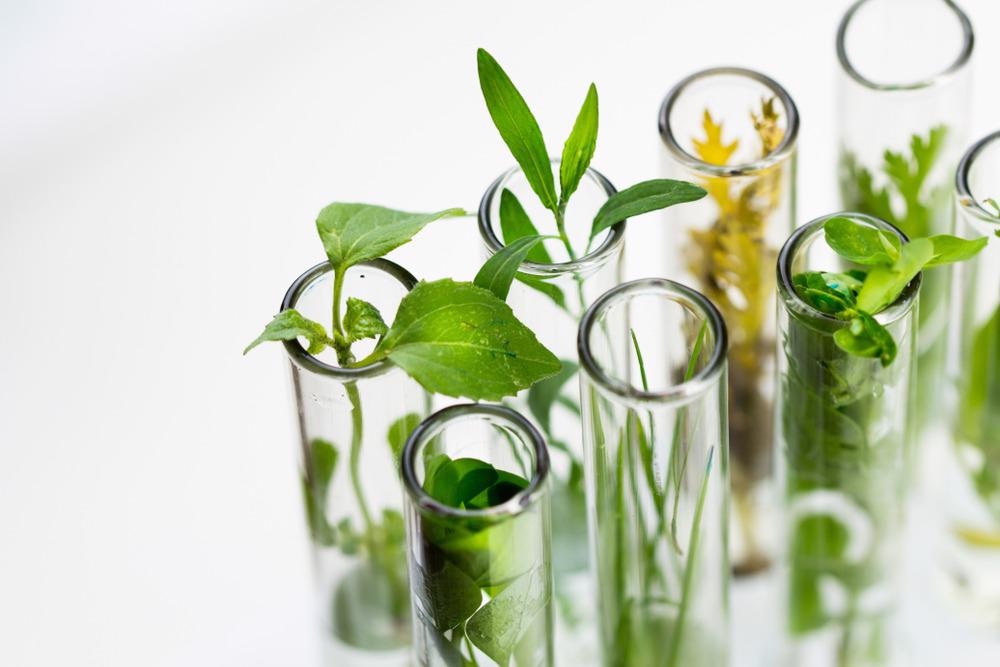A review in the journal Applied Materials Today has discussed biomedical applications and future prospects for plant-based hydrogels. The research was conducted by a team of international researchers from several countries including Iran, India, the USA, the UK, Germany, and Belgium.

Study: Status and future scope of plant-based green hydrogels in biomedical engineering. Image Credit: MW 3DStudio/Shutterstock.com
Hydrogels
Hydrogels are a class of soft material that has attracted the attention of multiple researchers since their first successful synthesis. Their programmable and tuneable properties have led to their use in several industries, most notably the biomedical sciences. Hydrogels can be produced from both synthetic and natural polymers, with research focusing on natural, renewable polymers due to their biocompatibility, abundance of resources, eco-friendliness, cost, and biodegradability.
In tissue engineering especially, hydrogels have been widely investigated due to their structural similarities with the body’s extracellular matrix. Loading hydrogels with cells provides a three-dimensional microenvironment that facilitates cell function, proliferation, and survival and helps to regenerate damaged tissues. Using hydrogels for tissue engineering overcomes the limitations of conventional strategies, which typically require multiple surgical interventions and can carry an infection risk.
Several strategies have been proposed for engineering polymer scaffolds, with freeze-drying emerging as highly suitable. Organic solvents are not used for the fabrication of scaffolds and optimizing different parameters can control properties such as pore size. Plant-protein hydrogels, such as those based on soy and zein have proven to be promising materials for use in drug delivery systems and tissue engineering. Moreover, several plant-based polymers have displayed potent antioxidant and antimicrobial properties.
The review study in Applied Materials Today has thoroughly investigated the current applications of plant-based hydrogels and scaffolding elements for tissue engineering and drug delivery purposes and provided perspectives on the future of research in this field. Four hundred and fifty studies have been included in the paper’s literature review.
Plant Sources for Hydrogels and Advanced Biomedical Applications
There are approximately three hundred thousand known species of plant on Earth, of which around five thousand have been studied for biomedical applications. Humankind relies on plants for food and numerous industrial activities. There exists, therefore, a vast range of species that could have potential for medicinal and advanced biomedical applications.
More from AZoM: Introducing Industrial Biotechnology in the Chemical Sector
Plants contain several materials that are attractive for hydrogels and structural elements in tissue engineering, such as cellulose, carbohydrates, proteins, nucleic acids, lipids, and so forth. Additionally, water soluble compounds such as flavonoids and alkaloids are of very high interest to researchers. There is an increasing demand for plant materials due to environmental impact, cost, their non-toxicity, and the urgent need for a more renewable, circular economy.
Green Hydrogels Derived from Plant Sources
The need to improve sustainability and the abundance of different plant species and the chemical and physical properties of their primary and secondary metabolites and structural components has facilitated an increasing focus on synthesizing plant-based green hydrogels. However, cellulose in its natural state can be difficult to retrieve from plant materials and is highly insoluble.
A one-pot bifunctional hydrogel synthesis method can be achieved using hairy cellulose nanocrystals. Chlorite is used to partially oxidize cellulose fibrils, which yields bifunctional fibrils that possess both carboxylic acid and aldehyde groups. Upon mild heating, these groups fall apart. The synthesis of these nanocrystals forms bifunctional hydrogels without the need for post-purification.
Several plant-based green hydrogels have been researched including chemical cellulose hydrogels, physical cellulose hydrogels, lignin-based hydrogels, plant protein-based hydrogels, hemicellulose hydrogels, starch-based hydrogels, plant gum-based hydrogels, soy-based hydrogels, and pectin-based hydrogels. There has been significant research into the synthesis, characterization, and improvement of the properties of plant-based green hydrogels.
Biomedical Applications
Plant-based green hydrogels have been explored for a variety of biomedical applications in recent years. Several types of hydrogels including cellulose, lignin, pectin, and plant gum-based hydrogels have been explored as drug delivery systems. Soy and zein-based hydrogels are the most commonly used plant protein-based hydrogels for drug delivery.
In tissue engineering, lignin, cellulose, hemicellulose, plant protein, starch, and pectin-based hydrogels have been investigated thoroughly in several studies. Amongst the significant amount of research in this area, combining cellulose matrices with cellulose matrices has proven particularly promising. For both drug delivery and tissue engineering, each hydrogel possesses attractive properties which make them suitable for different applications, and much research has concentrated on improving their physical, physiochemical, and mechanical properties.
Future Prospects and Perspectives
The study in Applied Materials Today has highlighted the tremendous potential for plant-based hydrogels in biomedical applications. Based on their review, the authors have proposed several future perspectives for research including hydrogel composites, optimization of fabrication processes, modification of natural plant-derived polymers, and research into enhancing biodegradability. Moreover, the authors have stressed the importance of more interdisciplinary dialogue and approaches in the future.
Further Reading
Mohammadinejad, R et al. (2019) Status and future scope of plant-based green hydrogels in biomedical engineering [online] Applied Materials Today 16 pp. 213-246 | sciencedirect.com. Available at: https://www.sciencedirect.com/science/article/abs/pii/S2352940719300332
Disclaimer: The views expressed here are those of the author expressed in their private capacity and do not necessarily represent the views of AZoM.com Limited T/A AZoNetwork the owner and operator of this website. This disclaimer forms part of the Terms and conditions of use of this website.